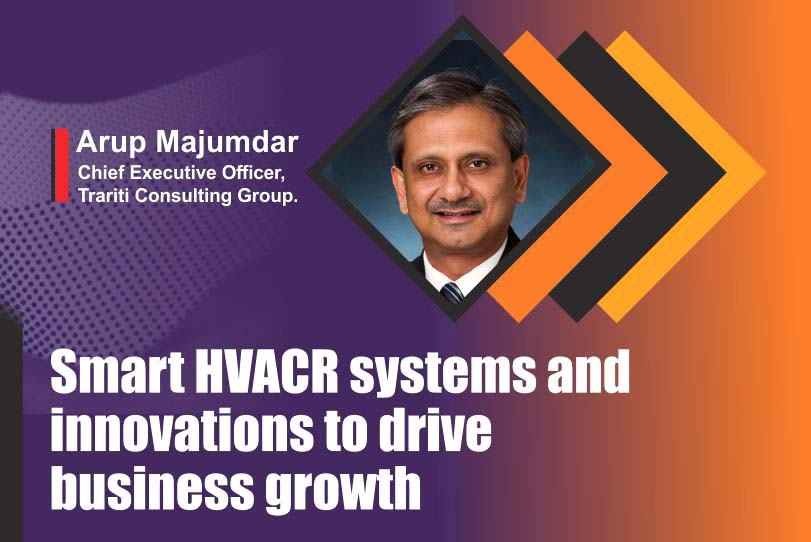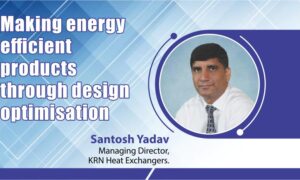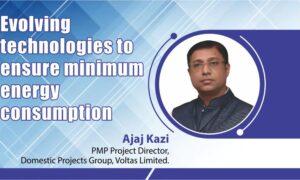Talking about IoT, there are three technologies: smart sensors, internet connectivity to places where data is stored, cloud storage and computing.
We need to ensure the rapid acceptance and introduction of certain technologies. We are seeing the technology shifts in the HVACR space. We started off with mechanical improvements trying to improve the efficiency of certain components and then moved on to electronic performance, from an AC inverter to a DC inverter. However, refrigerant change moved on to 410A, HFO blend, and we are moving in the direction where we are using more AI, cloud and data.
Using technology in terms of developing industry
We are moving into a space which is moving fairly rapidly away from mechanical movements, more into electronics and communication. And that is where the big picture is coming to us, but how we can integrate more of electronics communication and the power of shooting in the cloud in order to enhance the services to the people who are going to use it. Now everybody has a split AC at home. And, we are going through a fully integrated solution and moving rapidly towards different stages. We are moving to an area of fully integrated form in other aspects of the buildings or residences, for example, the security system, lighting system, garage, and now with the advent of the electric mobility, the electric charging stations in the homes. So now we are talking about a fully integrated system where all the equipment which uses electricity in some form or the other gets better into a centralised system that is what we’re moving towards.
IoT and 3 technologies
When we talk about IoT, there are three technologies we are talking about. The first is smart sensors. And sensors play a very important role in all this process, because that is the place where information is picked up. The second one is internet connectivity to mobile devices, as well as to remote storage places where you’re storing data. And then there is cloud storage and computing. Now, when we are taking information as we speak and in milliseconds taking a large amount of data, we have to process the data and for that, we need large computing power, which is easily available on the cloud. All this is making cooking easier, making machines more intelligent.
We can do fault detection diagnostics, asset management, predictive maintenance, and a whole host of value added activities that one can do, once you have real time data available. We have the power of ML and AI, which is enabling us to make better decisions based on certain historical data plus, machines using their own AI algorithms are able to figure out what to do in certain exigencies. It also allows for the customisation of different zones, according to different needs. IoT as an overall technology offers several benefits, which can be leveraged. When we talk about smart HVAC systems, there’s a demand side and there’s a supply side and there’s a sensor in between, which is a very important connection to link the demand side to the supply side.
Today, we have sensors of different types. We have pressure sensors, temperature, thermal sensors, movement sensors, particulate matter sensors, gas sensors, and a whole host of sensors. So the demand side is where you calculate what is required for the occupants inside the space in terms of temperature, humidity, cleanliness, safety, whatever is the parameter. And you will use a whole host of features. For example, if you look at the door sensor, the ceiling camera, an occupancy estimation algorithm can actually estimate the room occupants. And the supply side has to optimise the delivery of the right amount of cooling or heating in order to satisfy the room. So you can see from the demand side, there are several things that you can do. And all is moving up from the mechanical side to more of the electrical electronics. The people who are involved in industry have to take into account that HVACR has been a mechanical industry. But now the paradigm shift is happening. The technological advancements that are happening in this space.
The idea which I want to give to all of you is that if you look at this commercial building, then a lot of parameters in this building can be controlled. Basically, what you can do, you can improve and manage their quality, manage energy performance, provide real time data input, you can provide a healthy and safe environment, maintenance and even provide a whole host of activities, and it all boils down to information data. So data from the building is taken to a centralised place. It is monitored, analysed, and algorithms will tell the system or tell the operator whoever that person is intervening in the process to do certain checks and balances to make the system working properly.
Cooling as a service
The structure may look complex, but it just gives an idea of what is the power of having sensors, data and algorithms along with a backup of cloud computing and service to be able to address the needs of the building. Cooling as a service is slowly and increasingly becoming more important.
Cooling and service can be used for air conditioning and refrigeration. A simple analogy is that you pay for what you use. For example, if you consume electricity, you pay by the electric metre, and whatever amount of electricity is consumed, according to the metre, you pay for that. So cooling as a service, is basically you pay for the amount of cooling that you consume. So there is a provider of cooling services. It’s a centralised place, which provides cooling to different buildings. So the onus is on you to make sure that you consume less, and you will be more aware that I have to be careful about my consumption. The guy who’s the technology provider who provides the cooling solution, he has to ensure that his machine is more efficient, is more reliable, so that his operating costs are coming down. Both in cooling and refrigeration, we are seeing this model, especially in other developing countries, as cooling as a service is emerging. And that is when we make a lot of business model changes in the HVACR effect.
Technology: what it means to technicians in our country There are over two lakh of HVAC technicians. Today, when we look at our service needs, we do it based on the time in a year. But instead, now you have been monitoring for sensors, you know whether your machine really needs the service or not. So the servicing contract that you have, instead of having it based on time, you make it based on requirement. Imagine the life of an AC technician, his life is basically busy during the summer months. The rest of the time, he’s probably not very loaded. But if you go for the possibility of horizontal integration, which means that data is coming from different parts, and a technician is able to handle not only one appliance of one brand, but he’s able to look at the holistic picture of what is required from a house, then his skill set also improves.
Business model change
There are two kinds of models. One is the aggregator model, where you combine all the appliances or electrical equipment, so it goes on into a home or you have a performance guarantee model where you ensure that when you service you say that your machine is working at a certain level. Take a simple example, you bought a five star machine, and you knew that it would save you a certain amount of energy. But after one year, after two years, is that machine still five stars, probably not.
Integration of mechanical engineering and electronic education
If you have real time data on the performance of the machine, you will know whether it is still a five star or has deteriorated to the level of three stars. And, that brings us to the last point that the integration of mechanical engineering and electronic education will become more and more important. Because service technicians are more adept at the mechanical side, a little bit on the electrical side, but not much on the electronic side. And that is a skill set which needs to be incorporated for these technicians to make them more capable and upskill them over a period of time. Now, if you look at the Global Innovation Index of 2021, he says that India is ranked 46.
Why don’t firms innovate? And if you talk to the company owners or MSE, we’ll know when they want something new. The future is forever. There’s no sense of urgency. We have to be process oriented, you know, our HVAC industry, we are conventional. Our profit margins are pretty low. We don’t have resources. People will give you all kinds of excuses why they cannot be innovative. But then, as a change, especially Covid has created a rapid increase in the pace of adoption of technologies and we see how new technologies are coming in. And so we have to have a mindset change to be able to introduce new technologies as they come into the market. If you look at a business, then the true value is added, the rest is all cost. Innovation, whether it is disruptive, or sustaining, creates long term competitive advantage. Innovation can be in the form of materials process, supply chain, marketing business model, we talked about the service, which is the business model, we talk about product, which is the technology we talked about using IoT leadership in this industry is very important. But, why don’t we invest in R & D. Our R & D spend is less than 0.5 percent as compared to other developed countries, which are using 3 to 4 percent of their spending on R & D, we don’t do that model R & D and that is where we should invest.
Consumer awareness is increasing; people are becoming more conscious of the fact that you have to protect the environment by going into something which is green. So this is an opportunity for a low environmental impact product, which means lower energy consumption. Mr. Arup concludes with a note, whether you are a small company or a large company does not matter. Whether you are early in the game or whatever that is, innovation in any form is a sustainable advantage.
Cookie Consent
We use cookies to personalize your experience. By continuing to visit this website you agree to our Terms & Conditions, Privacy Policy and Cookie Policy.















